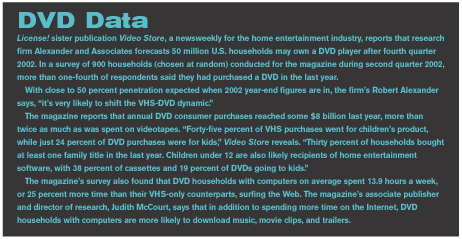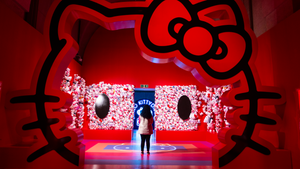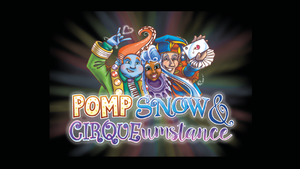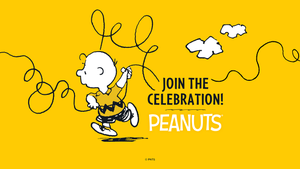Disc Space
]> Offering higher margins and more cross-promotional opportunities for licensed properties, will DVDs soon knock videocassettes off retail shelves? Isn't it amazi
April 6, 2018

]>
Offering higher margins and more cross-promotional opportunities for licensed properties, will DVDs soon knock videocassettes off retail shelves?

Isn't it amazing how something hot in a category can change everything?" muses Debbie Ries, senior vice president, global video sales & publishing, HIT Entertainment, home of Barney and Bob the Builder. 
That's certainly true about the licensing business in general and more specifically about the emergence of DVD (digital video disc), the multimedia entertainment platform synonymous with "sexy consumer commodity." An extension of the 20-year-old compact disc (CD), the five-inch digital video disc single-handedly offers licensed properties many opportunities to multi-flex their cross-promotional muscle in ways beyond the reach of comparatively clunky, limited-function videocassettes.
With a household penetration already at 40 percent (by the more aggressive estimates), after five years on the market, DVD buzz is even louder than its statistics suggest. In the 48-month span between calendar years 2000 and 2003, DVD production in the U.S. will quadruple, from 270 million units in 2000 to more than 1 billion units projected to be manufactured for U.S. consumption in 2003, according to video research firm Cambridge Associates in Stamford, CT. Cambridge President Dick Kelly says DVD production was 25 percent of total video units made in 2000. For 2002, it was projected to represent more than 60 percent of prerecorded units made, and this year 72 percent, or three times as many DVDs as VHS cassettes.
Classic Media "is thinking DVD first for our releases, and we're asking if we need VHS for a new release," says Robert Mayo, vice president, sales, Classic Media, home of Harvey Entertainment and Golden Book videos. Classic Media recently put out Underdog only on DVD, a first for the label. "Godzilla products are doing phenomenally well on DVD, and on VHS it is dying," Mayo reveals. He and others note the same customers who own a VHS title are replacing or upgrading it with the DVD version.
However, despite DVD's increasing popularity, VHS is still holding its own, particularly among the preschool set. The question is how long that situation will last. The slower adoption of DVD in the young kids' market is attributed in part to higher prices, the shortage of titles until now, families' sizable libraries of VHS kidvid, and parents' and their toddlers' familiarity and comfort with handling VHS. "It's harder for kids to navigate a DVD remote control," notes Kristin Sands, senior brand manager for Anchor Bay Entertainment. "The younger the consumer, the longer he or she will use VHS."
Extra Features = Extra Cost
The myriad charms of DVD-easy handling, storage, and portability; superior picture and sound; and capacity to contain all manner of interactive and computer-connected content-add up to premium price points.
A property on DVD can command anywhere from $2 to $10 more than its VHS version.
Artisan Entertainment's Barbie as Rapunzel, licensed from Mattel, is $19.98 on VHS or DVD, but that price parity is a rare exception. More typical are titles such as Barney's Christmas Star, from HIT Entertainment, $14.95 on VHS, $16.99 on DVD; Columbia TriStar's Maggie and the Ferocious Beast: Adventures in Nowhere Land, $12.95 VHS, $19.95 DVD; and Classic Media's Rudolph the Red-Nosed Reindeer or Frosty the Snowman, each $9.98 VHS, $19.98 DVD.
The differential owes to extra content, in the form of special features; or, for a TV series, more episodes; or, as for Thomas & Friends, for a toy such as a wooden train packaged with the video. Typical extra features on a preschool DVD are a sing-along video, read-along story, interactive coloring and counting activities, and a video-clip scrapbook. All of these are on Salty's Secret & Other Thomas Adventures from Anchor Bay Entertainment, which recently renewed through 2008 its licensing agreement with Gullane Entertainment-now owned by HIT Entertainment, which controls rights to Thomas the Tank Engine and Guinness Book of World Records.
Suzanne White, vice president, marketing, family, and catalog, Columbia TriStar Home Entertainment, says the label routinely puts at least 50 percent more content on its DVD version than on the VHS of the same title. For Maggie: Adventures in Nowhere Land, there is a bonus story on the DVD, interactive menus, and episode selections. On Rudolph, the evergreen animated TV staple narrated by Burl Ives, for a $10 DVD premium, Classic Media gives the consumer an interview with animator Arthur Rankin, a trivia game, a Spanish version, and a segment not seen in 30 years. For Frosty the Snowman, the higher DVD price brings a double feature (Frosty Returns) versus the single-episode VHS.

Curiously, such "extras" have become standard on many DVDs-particularly hit Hollywood features-but there's little consensus on the degree to which supplemental material affects a parent's or child's purchasing decision. Ries says HIT's consumer research indicates special features come in "a distant third" as a buying influence. First is the program itself and second is the price. Classic Media's Mayo vouches for his 6-year-old son's indifference to hearing a voiceover commentary on his favorite cartoon show.
There is a flip side to the higher-priced DVD extras' equation. "When it's something store buyers believe they don't have to take," explains Mayo, "they'll pressure the DVD price down closer to VHS, like $12.98. The [retail] buyers are the gatekeepers, and they are making decisions based on price, not title." By this year-end, he says, his company forecasts 55 percent to 60 percent of its unit sales will be VHS, but "revenue is opposite," he adds, with 60 percent coming from DVD and its higher pricing.
The economics of wholesale margins on $10 DVD pricing virtually preclude extras, with their extra production costs, but that's not a concern, say Mayo and others. Mass merchants that demand low-ball pricing, such as Wal-Mart and Target, cater to a clientele-price shoppers and children-that isn't influenced by extras on catalog titles. Besides, notes Anchor Bay's Sands, the cheaper catalog DVDs are "better for library building."
Even on higher-priced DVDs, adding special features also may depend on availability of rights and royalty structures. When Artisan released the first DVD+CD for Blair Witch 2, it intended to include the entire soundtrack CD on the same disc as the DVD. Yet, "the stumbling block became music royalties," says Steve Beeks, president of Artisan Home Entertainment, so Artisan instead settled for selected tracks on the CD portion of the disc.
Beeks projects DVD catalog pricing, already at $14.98 for many titles, will catch up, or down, to the $9.98 point "in the next 18 months." Inevitably, as DVD pricing declines, it will pressure VHS pricing even lower.
For a specialized genre such as anime, adult-themed Japanese animation aimed at teen and college consumers, it's easier to charge upward of $30, says John Parker, president of Tokyopop, as long as you pack in five episodes. He sees DVD pricing paralleling that of CD, with frontline, midline, and catalog tiers.
Part of DVD's draw for Al Kahn, chairman and CEO of 4Kids Entertainment-licensor of Pok/n-is there can be dual pricing (and dual inventory) on a single title to reach two distinct audience segments. "While different price points are hard to hold on VHS, even with first-run movies, on DVD there always will be a market for something special, no matter how deep the penetration into homes," he says. Though he believes "it's silly to suggest the marketplace could support both DVD and VHS into the future," Kahn sees DVD supporting certain titles in both a plain version, as on VHS, and also in a collector's version with extras at a higher price.
Right now, though, VHS is the predominant format for preschool product. Videotape commands 80 percent of unit sales for labels such as Anchor Bay on its flagship line, Thomas & Friends, with a target demographic of 2- to 5-year-olds. DVD is "growing at a slower rate," says Anchor Bay's Sands, "because parents are keeping the VCR for kids, and have a significant VHS library." She sees DVD gaining in the next few years, but doesn't see it going "too far beyond 30 percent" for her preschool category of titles.
4Kids' Kahn pegs his DVD unit sales at 20 percent on a given title, but he considers even that modest percentage "aggressive." Unlike Sands, he sees the digital portion of his sales shooting to 50 percent, if not 60 percent, a year from now "or faster." In three to four years, he says, "the predominant format certainly will be DVD."
At the other end of the spectrum is a specialty genre such as anime, whose "early-adopter and technologically progressive customer" almost exclusively prefers DVD to VHS, says Tokyopop's Parker. More than 95 percent of his video sales are in DVD.
In between are brands such as Barbie, with 45 percent of Rapunzel sales projected to be DVD, says Artisan's Beeks. By contrast, the company's Family Home Entertainment label has seen its Clifford the Big Red Dog move more than 2 million VHS units, with DVD just starting to emerge for that franchise. Beeks notes, "These last few months, it changed dramatically for our theatrical product." Artisan movies, such as Quentin Tarantino's Reservoir Dogs, rack up as much as 70 percent of their sales on DVD.
Beeks says he expects to start seeing the first major movie suppliers exiting VHS "inside of 18 months. In a few years, you can definitely say we won't produce any VHS." By 2005, he says, "VHS will become a dribble, with single-digit market share." He sees VHS enduring for children's product a little longer, into 2007.
Retail Room for DVD
What does all this mean for retailers? Learning Express, a specialty retail chain based in Ayer, MA, specializes in developmental children's products, but pays scant attention to DVD. The format is merchandised in perhaps a dozen of its 125 stores, says Lisa Visco, vice president, merchandising. Its list of approved vendors includes software jobbers Fast Forward and Rounder, but on its "suggested store inventory mix," says Visco, "you won't see DVD.
"Our retailers are not going to lead the trend, but follow the trend, because they need product that's going to turn for them," she says. "Customers think to come to our store for a Thomas the Tank videocassette, but they'll go to Best Buy for a DVD. Down the road, we'll carry it." Learning Express voluntarily is behind the curve on DVD because video is only 1 percent of its business.
Classic Media's Mayo, whose two-decade career spans the history of video distribution, says, "In 2003, mass merchants Wal-Mart, Kmart, and Target will still be buying VHS, while Best Buy and other electronics-type stores will be out of it. They might limit themselves to A titles on VHS, such as Spider-Man." As 4Kids Entertainment's Kahn explains, "Retailers get a better margin for DVD, can fit more skus into the same space as one VHS, charge more money, and their sales per square foot go up." Still, he adds, "the critical mass is not there to totally usurp VHS for the next couple of years."
Mayo also says that "if buyers are ahead of customers in depleting VHS inventory, they won't know until the first quarter of this year." Over the years, VHS sell-through in the fourth quarter on a top title averages, he says, from 83 percent to 86 percent. "If VHS sell-through is at 100 percent with no returns, we'll know we missed business on VHS."
Some suppliers are creating customized programs to make it worthwhile for retailers to showcase DVD. Tokypop's Parker says the anime company is planning a spring 2003 promotion with a mall chain by creating a DVD sampler featuring episodes from its various anime series that will be given away free with the purchase of any Tokypop item. In October 2002, it released a limited-edition novel-and-DVD package of Real Bout High School, priced at $30.
"With the music business in disarray, those chains are looking for new revenue streams," Parker says. He is happy to oblige with his various lines by "going to retailers and helping to sell it through instead of just selling it in, which has improved their performance. Retailers historically are not treated as partners in the manufacturing supply chain."
Parker says chains such as Suncoast, which has carried manga graphic novels for almost a year, are merchandising anime by brand instead of format, where anime videos, graphic novels, CD soundtracks, and other merchandise are displayed in a cluster.
Cross-Promotional Opportunities
DVD cross-promotions likewise have come a long way. In October 2002, Columbia TriStar Home Entertainment and General Mills launched a ground-breaking, three-month promotion in 20,000 grocery outlets with free DVDs packaged with 8 million "Big G" brand cereal boxes, including Cheerios, Golden Grahams, and Lucky Charms. Also featured was a "buy two, get one free" DVD offer at www.eatcerealgetfreedvds.com.
The cereal-box DVDs contained unique compilations not available elsewhere and trailers for upcoming Columbia releases such as Jim Henson's Kermit's Swamp Years. "Most of the properties previewed on the cereal boxes were preschool programs, for ages 2 to 6," says Columbia TriStar's White. "They have not exploded onto DVD like feature films."
Adds Lexine Wong, executive vice president of worldwide marketing for Columbia TriStar Home Entertainment: "This promotion was a terrific way to reach the family market, which is increasingly important to the DVD industry. Family and kids' programming are the two fastest growing segments of the DVD market."
Preschool TV series Maggie and the Ferocious Beast, first released on DVD and VHS by Columbia TriStar in August 2002, is typical of the fare on the free General Mills DVD compilations. At Maggie production company Nelvana-which has no plans for phasing out VHS-Shari Zitzow, marketing manager, home video, says, "When you have a brand like Maggie, where awareness is low, these new lines of distribution and promotion help garner attention. We can only hope these extra outlets translate to additional unit sales.
"On another note," she continues, "we can use games created for the Web, reformat them for DVD, and recoup some costs through our licensees. You can add licensee trailers, games, you name it, in the 'extras' section. DVD is an incredible vehicle for a merchandising program; it is a driver."
You May Also Like






